
Welcome to sandiegosnakes.com! I am David, a snake enthusiast living in San Diego, CA. Many people don't know that San Diego is in fact full of snakes! You just need to know where to find them - they can often be shy and elusive. Some California snake species are more common outside of the city limits, in different parts of San Diego County CA, but many types of snakes are indeed common in the more urban parts of San Diego. This guide is meant to help educate you about the beautiful snakes of San Diego, and to help you identify the most common snakes of San Diego, as well as the venomous snakes of San Diego that you should learn to recognize and avoid. If you want more detail, click here for my complete list of ALL snake species in San Diego. Remember the following:
- Most snakes of San Diego are harmless and don't want to encounter you
- Venomous snakes exist but are uncommon in San Diego, California
- Snakes eat rats and mice and are a valuable part of the California ecosystem
- Never kill a snake - if you leave a snake alone, it will leave you alone.
Common Snake Species in San Diego
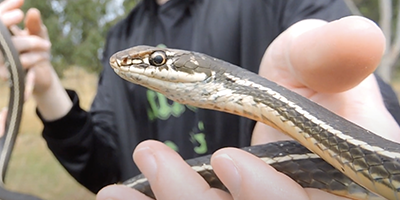 California Striped Racer:
These flat snakes are around three or four feet in length. Speedy and dark in coloration, their scales can be brown, grey, or black with a yellow or cream stripe. Largely diurnal, they prefer to hunt for food from high locations, and thus can be seen observing an area from trees or rocks. They eat rodents, birds, frogs, other snakes, and lizards, especially spiny lizards. Though not venomous, they don’t like being disturbed, and thus, like other racers and the coachwhip, they will bite aggressively if threatened and unable to escape.
California Striped Racer:
These flat snakes are around three or four feet in length. Speedy and dark in coloration, their scales can be brown, grey, or black with a yellow or cream stripe. Largely diurnal, they prefer to hunt for food from high locations, and thus can be seen observing an area from trees or rocks. They eat rodents, birds, frogs, other snakes, and lizards, especially spiny lizards. Though not venomous, they don’t like being disturbed, and thus, like other racers and the coachwhip, they will bite aggressively if threatened and unable to escape.
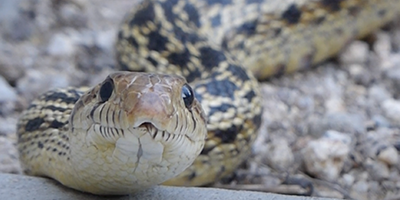 San Diego Gopher Snake:
These hefty snakes are one of several such subspecies found across California. This particular kind can vary in length from two and a half feet to as long as nine feet, making them the longest snake subspecies in the state. Generally, they’re only four or five feet in length, which is still respectable for a heftier snake. Their color varies but browns and tans are common hues, with a cream or yellow underside spotted with dark colors.
If weather permits they will be active in the day, but when it’s warmer they prefer dusk and dawn, as well as night. They feed mostly on mammals but will eat lizards and snakes as well. Fond of gophers, moles, and other burrowers, they will also eat birds and hatchlings. If threatened, they might play dead or inflate themselves to mimic a rattlesnake, including shaking their tail.
San Diego Gopher Snake:
These hefty snakes are one of several such subspecies found across California. This particular kind can vary in length from two and a half feet to as long as nine feet, making them the longest snake subspecies in the state. Generally, they’re only four or five feet in length, which is still respectable for a heftier snake. Their color varies but browns and tans are common hues, with a cream or yellow underside spotted with dark colors.
If weather permits they will be active in the day, but when it’s warmer they prefer dusk and dawn, as well as night. They feed mostly on mammals but will eat lizards and snakes as well. Fond of gophers, moles, and other burrowers, they will also eat birds and hatchlings. If threatened, they might play dead or inflate themselves to mimic a rattlesnake, including shaking their tail.
Venomous Snake Species in San Diego
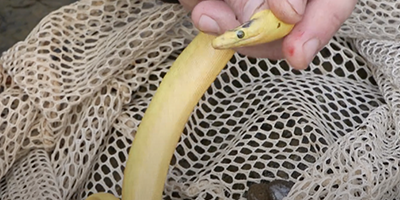 Yellow-Bellied Sea Snake:
Found off the coast of San Diego and the surrounding area, these aquatic snakes are venomous and thus potentially dangerous. Though sea snakes are generally incredibly docile, caution is always advised with venomous snakes. Usually around one to four feet in length, these brightly colored snakes can be dark brown or black with a distinctive yellow underside. Active during the day, they live in the ocean and feed off fish and eels. Though it was once thought that they filtered seawater to remain hydrated, it is now known that they drink fresh or low salinity water from recent rainfall and freshwater sources such as rivers.
Yellow-Bellied Sea Snake:
Found off the coast of San Diego and the surrounding area, these aquatic snakes are venomous and thus potentially dangerous. Though sea snakes are generally incredibly docile, caution is always advised with venomous snakes. Usually around one to four feet in length, these brightly colored snakes can be dark brown or black with a distinctive yellow underside. Active during the day, they live in the ocean and feed off fish and eels. Though it was once thought that they filtered seawater to remain hydrated, it is now known that they drink fresh or low salinity water from recent rainfall and freshwater sources such as rivers.
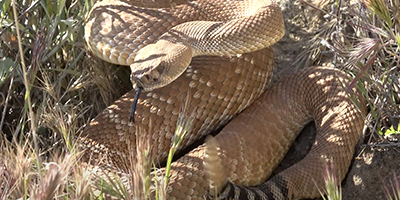 Red Diamond Rattlesnake:
Several species and subspecies of rattlesnake reside in California, and this is one that can be found in the San Diego area. Very venomous, they tend to be two to over four feet in length. Their coloration varies but can be pinkish, reddish, or brownish in hues. Males tend to be larger than females, which is unusual when it comes to snakes. Like most rattlers, they eat mammals and lizards, as well as birds. Adult California ground squirrels are immune to their venom and tend to fight back when a rattler tries to eat them.
Red Diamond Rattlesnake:
Several species and subspecies of rattlesnake reside in California, and this is one that can be found in the San Diego area. Very venomous, they tend to be two to over four feet in length. Their coloration varies but can be pinkish, reddish, or brownish in hues. Males tend to be larger than females, which is unusual when it comes to snakes. Like most rattlers, they eat mammals and lizards, as well as birds. Adult California ground squirrels are immune to their venom and tend to fight back when a rattler tries to eat them.
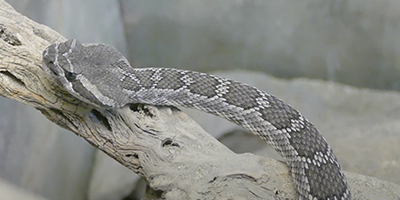 Southern Pacific Rattlesnake:
Another rattlesnake found in the San Diego area, this one is usually thirty to forty-four inches long, so not quite three to four feet. Rather hefty for their size, these snakes are usually brownish in color, with a blotched pattern outlined in black. Largely nocturnal, they sense heat and thus tend to mostly eat small mammals. They will also eat birds, lizards, snakes, and frogs, and the young eat insects. Very venomous and thus very dangerous, as though rattlers will give a warning with their distinctive tails, if threatened or aggravated they will bite, and rattler venom is not to be taken lightly.
Southern Pacific Rattlesnake:
Another rattlesnake found in the San Diego area, this one is usually thirty to forty-four inches long, so not quite three to four feet. Rather hefty for their size, these snakes are usually brownish in color, with a blotched pattern outlined in black. Largely nocturnal, they sense heat and thus tend to mostly eat small mammals. They will also eat birds, lizards, snakes, and frogs, and the young eat insects. Very venomous and thus very dangerous, as though rattlers will give a warning with their distinctive tails, if threatened or aggravated they will bite, and rattler venom is not to be taken lightly.
If you're unsure, you can email me a photo of the snake at info@sandiegosnakes.com and I will email you back with the snake's species. If you found a snake skin, read my Found a Skin? page, and you can email me a photo of the skin, and I'll identify the snake for you. If you need professional San Diego snake removal help, click my Get Help page, or see the below website sponsor I found, who provides that service.
Do snakes drink water?
All animals require water to survive. All living things need water to survive. Snakes need water to drink and hydrate themselves. They are unable to get all of the water they need from the prey they choose alone.
Despite having a large, forked tongue, the snake doesn't actually use this as it drinks. Instead, it lowers its head into the water and drinks almost in the same way that a human would. It does use its tongue to figure out where the water is, of course, but the muscle doesn’t get used in the drinking process.
Quite a few videos have been doing the rounds on social media depicting a snake drinking from water bottles and similar and you'll see that the snake’s jaw/cheeks move in each one. Snakes will literally lower the bottom half of their heads in a puddle of water and drink.
In some places, such as the desert, water is hard to find, but snakes have become very good at surviving on little to virtually no water. The rattlesnake, for example, is a perfect species for dry, sandy, and arid conditions. Many reptiles that live in the desert, the rattlesnake included, have even been seen collecting water on the dorsal surfaces, drinking it when required. It would seem that more and more hot-temperature snakes in areas of low rain are depicting this behavior, showing that snakes do not just get the water they need through drinking out of a puddle alone.
Remember, the term is not poisonous snakes of San Diego, it's venomous snakes of San Diego. Poison is generally something you eat, and venom is injected into you. That said, dangerous snakes are very rare in San Diego. The few venomous snakes of San Diego County are rarely seen. But they are commonly misidentified, so learn about all the snake species of San Diego in order to correctly identify them. These snakes are usually also found in the surrounding towns of Chula Vista, Carlsbad, Oceanside, Coronado, Escondido, El Cajon, Encinitas, Vista, Poway, San Marcos, Del Mar, La Mesa, National City, Santee, Imperial Beach, Fallbrook, Spring Valley, Lemon Grove, Rancho Santa Fe, Solana Beach, Alpine, Ramona, Camp Pendleton North, Julian, Lakeside, Bonita, Valley Center, Jamul, Borrego Springs, Rancho San Diego, Jacumba Hot Springs, Tecate, Rainbow, Pine Valley, Casa de Oro-Mount Helix, Bonsall, Mount Laguna, Descanso, Campo, Potrero, Lake San Marcos, Fairbanks Ranch, Granite Hills, Camp Pendleton South, Harbison Canyon, Shelter Valley, Boulevard, and the surrounding areas.
Read our article about:
How to kill a rattlesnake
sandiegosnakes.com domain and hosting costs made possible by the generous support of this sponsor:
